

.
.
.
.
.
.
Meanwhile….

.
.
.
.
.
.
.
.
.
Musings on biblical studies, politics, religion, ethics, human nature, tidbits from science



.
.
.
.
.
.
Meanwhile….

.
.
.
.
.
.
.
.
.

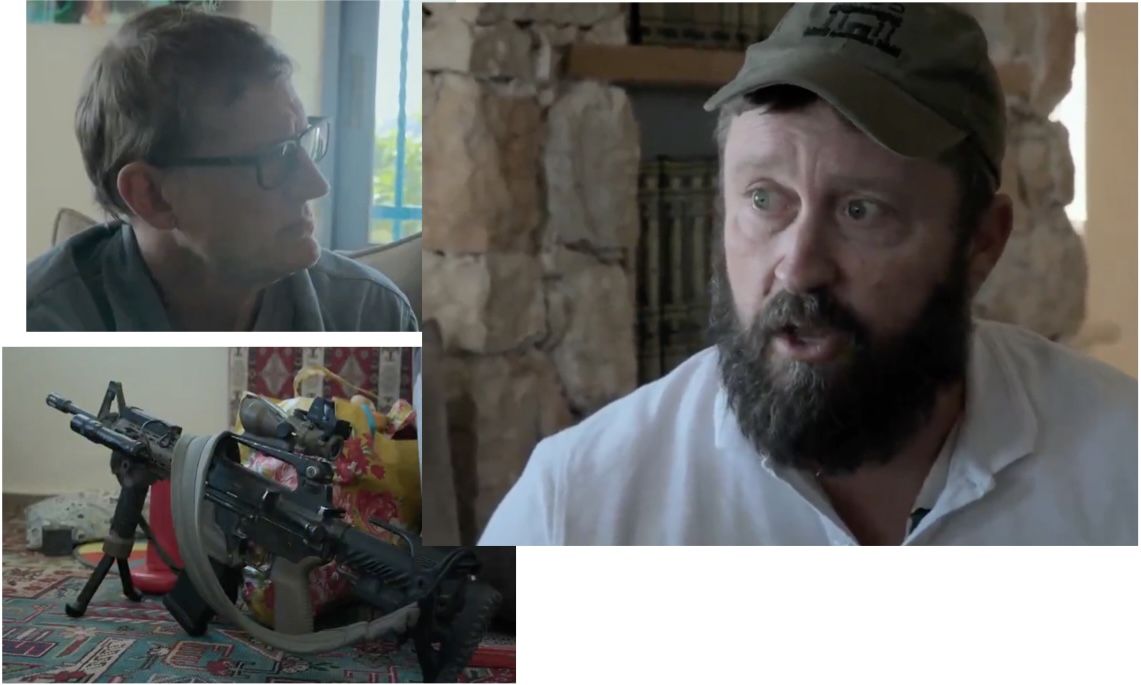
I transcribed a portion from Louis Theroux’s recent documentary, The Settlers, where he is interviewing Ari, from Texas, now a West Bank settler….
After recalling previous discussions about Ari’s view of the importance of Jewish presence in “the biblical land of Israel” . . . .
Theroux: 50:22 Are you saying that you see Israel as playing a role for modelling a new kind of nationalism, is that right?
Ari: 50:30 I think all that’s happening in the world right now is leading us as a nation to open our eyes to who we are. We are the tip of the spear fighting the battles of America and defending the entire Western world, and not just the Western world – anyone who wants any semblance of liberty and freedom in their lives.
Theroux: 50:52 Nevertheless, there are millions of people up and down the area, Arabs, Muslims, who aren’t living free right now. They’re enclosed without the same rights, without national self-determination, and in many respects feeling besieged, and I just wonder, do you see that?
Ari: 51:10 I don’t have tremendous compassion for a society that has an unquenchable, genocidal, theological, blood-lust. It’s like a death cult.
Theroux: 51:23 It’s easy with a danger with that kind of characterization of Palestinians to define them as eliminationist, and hateful, and genocidal, … are those the words …?
Ari: 51:32 Yes, I use the word death cult.
Theroux: 51:35 It’s a death cult… that that then permits you to almost create a mirror image of that, that you say, well, if they want to do that to us, then we need to do that to them.
Ari: 51:45 I think that when you’re living amongst people who have perpetually proven, not only by word, but by deed, that they want your blood spilled in the streets, that they want to murder your children, that they want to slay all of you, kill all of you in the most horrific genocidal way — That all of the polls showed after October 7, that these people who you continuosly call the Palestinian people – that I reject the very premise that they are actually a real nation for a lot of reasons, I mean….
Theroux: 2:15 But the millions of people who have nothing to do with October 7, who actually would just like to live free full lives
Ari: 52:24 If that’s really what they wanted they would have had it a long time ago. They want to wipe Israel off the map. They want every last Jew dead.
Theroux: 52:32 So what’s the answer?
Ari: 52:33 The answer is for us to declare sovereignty over all of Judea and Samaria, and all of the land of Israel, and Gaza, and to settle Gaza and all Judea and Samaria with Jews in the land of Israel.
Theroux: 52:50 Did the question annoy you?
Ari: 52:52 Annoy me? I hear it so often. And it feels like it’s being addressed again and again and again. Even if the entire world is pointing accusing fingers and gnashing their teeth in rage and anger, we know the righteousness and the truth of our cause, even if we stand alone. That’s what it means to be a Hebrew. That’s what it means to be a Jew. If we know the truth of our cause that’s all we need.

It is hard to bring oneself to blog about new things (in historical and biblical studies) that I am learning all the time when every day the news is recallibrating my identity as a citizen of the West.
As a little child I wowed the grownups when I naively asked why everyone was so sad that my great grandfather was dying. Isn’t he going to heaven, I asked. Shouldn’t we be happy? Aww — so innocent!
As a teenager school student I felt it safer not to ask my war veteran elders why it was “us” who declared war on the Axis powers and not the Axis powers on us. And why the fire-bombing of Germany and Japan and snuffing out two cities with atomic bombs? I sometimes wondered if a future generation would look back and see WW2 as a titanic struggle for domination between great powers. Our identity as the liberators of democracy and crushers of fascism was at risk if such questions were taken too far.
Now today we see nothing has changed in the project to control the Middle East. Mass murder is brought into our phones and tv sets daily. The only thing that has changed is the removal of the pretence. It was easier to be deceived when the powers said they were looking for peace and that the ongoing military build up and daily occupation was all about security. Now that pretence is gone and we can see it in all its mind-numbing reality. So our leaders remain silent and criminalize those who attempt to speak out.
We are the bad guys. World War 2 was a contest to see who would dominate the world. We won. The world lost. Yes, there was welcome progress in some areas, and despite the gap between rich and poor increasing that was a good thing. But even Hitler before the war did good things for the German economy and youth welfare. Now I feel like I understand a little how anti-fascists felt living in Germany under Hitler. The difference is the propaganda. Nazi and Soviet propaganda was crude by comparison. In this post I linked to a discussion about the attempt to silence journalists. That was old hat. Today at home they are being hauled before the courts while in the Middle East they are being murdered at scale.
It’s a heavy time. Apologies.
…..
P.S. — added later….
A few days ago there was a great kerfuffle in media, in talk shows, in comedy sessions, among government and political representatives — about a lapse in security involving talk about bombing Yemen. I strained in vain to hear from those talk-fests a word of outrage over the murder of innocent human beings in an apartment building. I can no longer bring myself to listen to some of those programs ever again.

Western support for Israel, I have heard, is in large measure rooted in an identification with a state that represents our Judeo-Christian heritage, our values. But on to another topic….
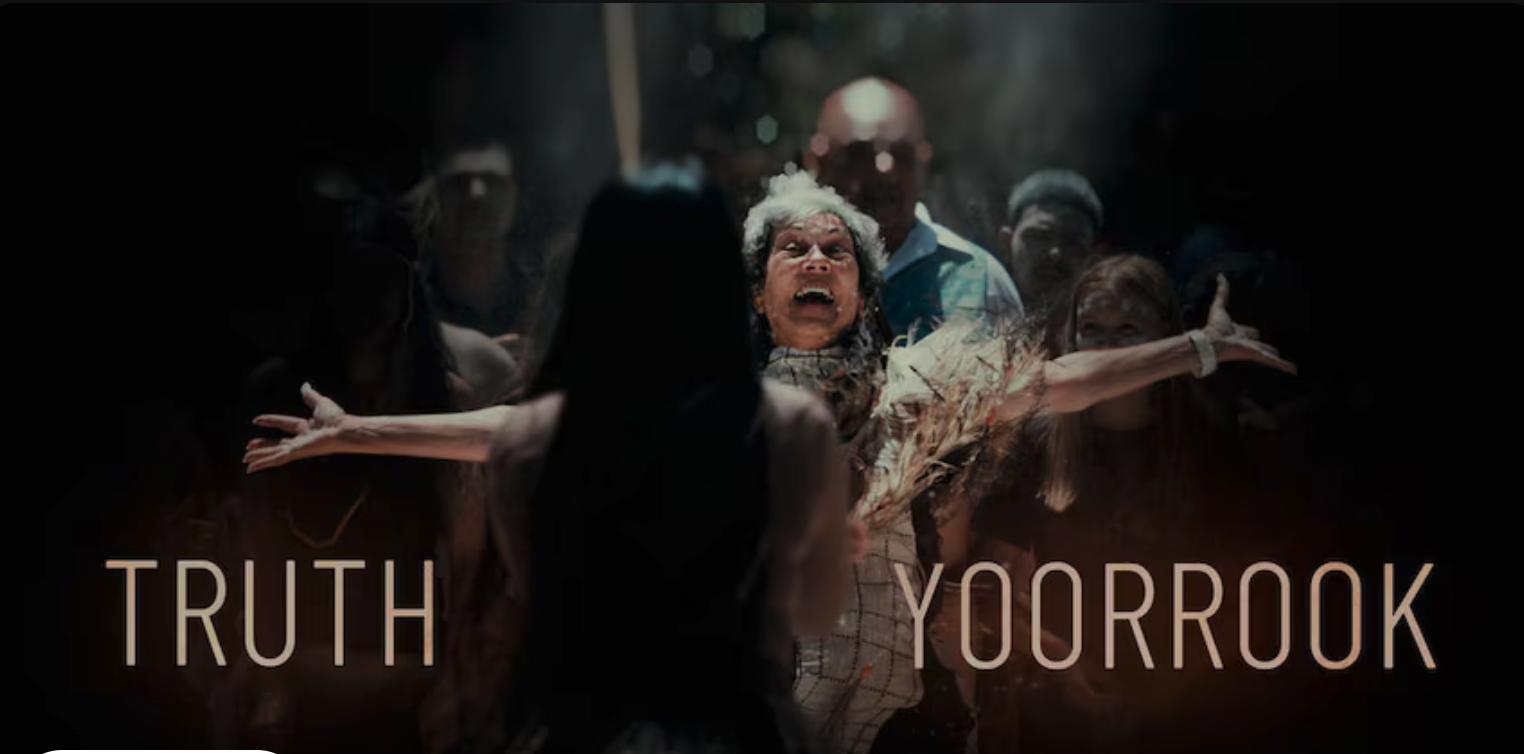 From https://www.abc.net.au/news/2025-03-24/truth-yoorrook/105090138
From https://www.abc.net.au/news/2025-03-24/truth-yoorrook/105090138
ELIZABETH BALDERSTONE: There’s many historians who’ve written a lot on this and researched in depth the story of what happened here. There were clearly issues and skirmishes between the traditional owners and the settlers and culminated in mid-1843 the murder of a fellow, Ronald Macalister, who was the nephew of a very wealthy pastoralist from New South Wales. In retaliation for the murder of Ronald, it’s understood that a group of settlers known now as the Highland Brigade got together and came upon a large group of Brataualung people camped at Warrigal Creek at the waterhole.
BRIDGET BRENNAN, REPORTER: Historical records are patchy. University of Newcastle researchers now estimate that at least 125 men, women and children were shot dead in a five-day rampage in the area. In 1925, a Gippsland magazine published this anonymous account of the massacre.
MASSACRE ACCOUNT: “Some escaped in the scrub, others jumped into the waterhole, and, as fast as they put their heads up for breath, they were shot, until the water was red with blood… I knew two blacks who, though wounded, came out of that hole alive. One was a boy at that time, about 12 or 14 years old. He was hit in the eye by a slug, captured by the whites, and made to lead the Brigade on from one camp to another.“
The media cheered the war on “the savages”, praising the heroic efforts of the defenders of white Judeo-Christian values. Addressing similar massacres in Queensland….
As he set out for Cardwell, newspapers were still applauding the exploits of this “most indefatigable and energetic officer”. The story of the Hermitage campaign reached Scotland, where the meaning of “prompt justice” had to be spelt out for readers. The Perthshire Journal wrote: “Prompt justice was done to them, and the blood-thirsty cannibals, one and all, bit the dust.” Once in Cardwell, Uhr swiftly won the approval of The Port Denison Times: Our black brethren have been keeping quiet lately, and I have not heard of any depredations having been committed by them; no doubt they have been kept in awe from the fact of our gallant Sub-Inspector and his ‘brave army’ having been amongst us, preventing them from ‘kicking up a row.’ (Marr, Killing for Country, 286)
Newspapers published condemnation of “bleeding hearts” who protested the violence whenever it came to their attention. The protests were too few and isolated. Overall, silence prevailed. Ignorance was a virtue.
Philip Sellheim had tramped the bush with Dalrymple and endeared himself to the Commissioner of Crown Lands by writing to newspapers pouring scorn on city folk who, blind to “the savage character of the aborigines”, were agitating for the removal of the Native Police from the Kennedy: “The pioneer settlers of the north will not tamely allow their risks and arduous labors to be undervalued by any ignorant individual, living in a well-protected township, who, to further his own private ends, perverts truth and risks the lives of his fellow-creatures.” (Marr, 270)
The blacks, of course, killed only out of hatred for the whites, not for any conceivably justifiable reason:
“Psalm-singing hypocrites”, D’arcy called them and returned fire: These men, Mr. Editor, speak without experience, speak as their mind guides them; such is the case now in the moral city of Adelaide. Morality amongst the wild tribes is not known. I thoroughly endorse Mr. Alfred Giles’s sentiments, and say that all the tribes that I have met with—and I have made the acquaintance of a few—nearly always try to force you to take their women as a peace offering, or decoy to get a good opportunity of attack… I could, Mr. Editor, relate dozens of instances where men have been murdered without any cause. (Marr, 381)
The silence was so pervasive that subsequent generations simply did not know that the massacres had happened. Later scholars would attempt to look into how this country was built and were denounced by the Prime Minister John Howard as creating a negative “black arm” version of history. Still today many cannot bring themselves to believe that their ancestors took this land through genocide.
I was watching a youtube video of a recent episode of the Steven Colbert show. He tackles any controversial topic except one. Though to his credit he did mention the ongoing Gaza slaughter in a sanitized quip: he said something to the effect, “No matter what your views are on the current….” — as if different views were like supporting different sports teams. All equal: just differing opinions that we don’t want to intrude and spoil the show. One more brick in the wall of silence.
I’ve sometimes heard condemnation of Germans in the Nazi era keeping silent though they are said to have known what was happening to Jews who were being transported out of their neighbourhoods. I can understand the thread of deportation making one think twice before speaking out. But the rest of us today…. what excuse is there?


Here I continue a series I began in July 2010 — a history of the Zionist movement as documented from official archives and personal diaries by the Palestinian historian Nur Masalha.
I have long held off from completing that task, most especially since recent events in Gaza and now the West Bank and Lebanon left me feeling that the current traumas are too suffocating to allow anyone to think of the past. But the past is important for understanding what is happening today.
The following account makes it clear why current events did not begin with the Hamas attack on October 7 2024. It will all sound so horrifyingly familiar that you that you may find yourself wondering if you are reading history or today’s news stories.
| “What did the world do to prevent the genocide of the Jews? Why now should there be such excitement about the plight of the Arab refugees?“ |
We may have heard that Arabs fled wholesale of their own free will when the state of Israel was declared in May 1948.
The plight of these Arab refugees and the problem they posed deserve attention . . . A huge and pitiful multitude, uprooted, exploited and helpless, they numbered at their height approximately 750,000. . . .
Superstitious and uneducated, the Arab masses succumbed to the panic and fled. . . .
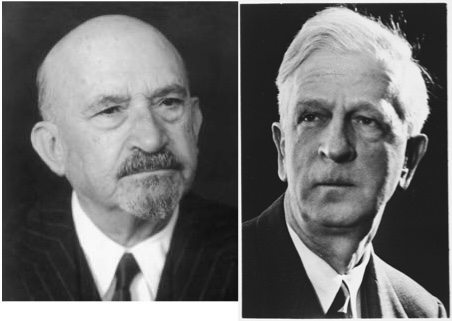
Certainly, [the big three — Weizmann, Ben-Gurion or Sharett] had been quite unprepared for the Arab exodus; no responsible Zionist leader had anticipated such a “miraculous” clearing of the land. Dr. Weizmann, despite his ingrained rationalism, spoke to me emotionally of this “miraculous simplification of Israel’s tasks,” and cited the vaster tragedy of six million Jews murdered during World War II. He would ask, “What did the world do to prevent this genocide? Why now should there be such excitement in the UN and the Western capitals about the plight of the Arab refugees?” — First United States Ambassador to Israel, James G. McDonald, p. 174ff
Such a carefully worded narrative positions the Arab “exodus” of 1948 as a sadly inferior foil to the biblical Jewish exodus, even a matter of divinely ordained compensation for one party at the “tragic” expense of “pitiful, superstitious, cowardly masses”. MacDonald does elsewhere express some pity for the Arabs along with regret that the Israeli approach was not “more humane”. But the purpose of these posts is to cite what the Israeli leadership were in fact thinking and planning — how the Zionist program planned for and enforced the Arab evacuations.
Let’s back up a few months and into the year before Israel declared its actual birth.
2 November 1947: A vote by the United Nations General Assembly was imminent. The UN was scheduled to declare that Palestine should be partitioned between Jews and Arabs and that the Jewish state would contain a large Arab population (42%). The leading Zionist organization, the Jewish Agency Executive, met and agreed that citizenship should not be granted to the Arabs in the soon-to-be-established Jewish state. The reason was stated by Ben-Gurion:
In the event of war between the two Palestine states, said Ben-Gurion, the Arab minority in the Jewish State would be ‘“‘a Fifth Column.”’ Hence, it was best that they be citizens of the Palestine Arab State so that, if hostile, they “‘could be expelled”’ to the Palestine Arab State. But if they were citizens of the Jewish State, “‘it would only be possible to imprison them, and it would be better to expel them than to imprison them.”’ (Benny Morris, 28, citing the minutes of the Jewish Agency Executive meeting)
29 November 1947: The United Nations General Assembly passed resolution 181 endorsing the partition of Palestine into 2 states: Arab and Jewish, with Jerusalem and Bethlehem forming an international zone. The boundaries drawn up meant the Jewish state would consist of a 42% Arab population.
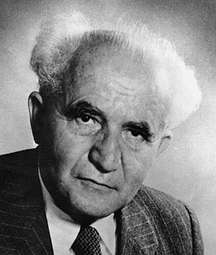
30 December 1947: Ben Gurion addressed the Histadrut and declared that the Zionist settlers of Palestine would need to learn to think “like a state”:
There can be no stable and strong Jewish state so long as it has a Jewish majority of only 60 percent.
This, Ben-Gurion added, made necessary the adoption of “a new approach…new habits of mind to suit our new future. We must think like a state.” (Masalha, 176; Morris, 28)
But what kind of state should Israel “think like”?
The kind of state in Ben-Gurion’s mind was Turkey which had ethnically cleansed (or “transferred”) their Greek population. Eleven years earlier he had made it clear that there was “nothing morally wrong in the idea” but that it was the kind of thing only a state should carry out.
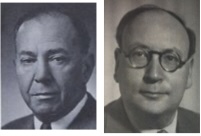
[Two non-Zionists, Senator and Hexter] vehemently opposed the transfer idea: ’there are Arabs in this country. The more we take them in consideration, the more we will succeed . . . .’ Senator considered transfer as fraught with danger: ‘We can’t say that we want to live with the Arabs and at the same time transfer them to Transjordan.’ In summing up the debate, Ben-Gurion stated that . . . the population exchange between Greece and Turkey could not serve as a precedent since it was a pursuant to voluntary agreement between two states: ‘We are not a state and Britain will not do it for us . . In Ben-Gurion’s view, the proposal would alienate public opinion, including Jewish public opinion, but there is nothing morally wrong in the idea’. (Flapan, 261)
We have encountered Turkey’s expulsion of the Greeks before as a debated model among early Zionists: Zionist Plans (1936); Pushing for Mass Transfer (1937); Compulsory Arab Transfer (1937); Caution and Discretion (1941).
Conflict Begins Before Israel’s Foundation in May 1948:
Within weeks of the UN partition resolution, the country was plunged into what soon became a full-scale civil war. By mid-December, “spontaneous and unorganized” Palestinian outbreaks of violence were being met by the full weight of the Yishuv’s armed forces, the Haganah, in what the British high commissioner called “indiscriminate action against the Arabs,”3 coupled with measures aimed at economic strangulation. Ben-Gurion advised on 19 December that “we adopt the system of aggressive defense; with every Arab attack we must respond with a decisive blow: the destruction of the place or the expulsion of the residents along with the seizure of the place.”4 On 30 December, a British intelligence observer reported that the Haganah was moving fast to exploit Palestinian weaknesses and disorganization, especially in Haifa and Jaffa, and to render them “completely powerless” so as to force them into flight.
The Palestinians were completely unprepared for war, their leadership still in disarray and largely unarmed as a result of the 1936-39 rebellion. The Yishuv’s defense force, the Haganah (to say nothing of the dissident Irgun Tzvai Leumi and Lehi groups), was fully armed and on the offensive. As early as February 1945, before World War II had even ended, the first of a series of master military plans adopted by the Haganah (which in turn was under the jurisdiction of the Jewish Agency) was in place in anticipation of the war for statehood. (Masalha, 176f. Note 3 = Middle East Centre, St. Antony’s College Archives, Oxford, Cunningham Papers, 1/3/147, “Weekly intelligence Appreciation.” A three-day general strike started on 2 December in protest of the United Nations resolution. Note 4, see quote from Flapan p 90 following…)
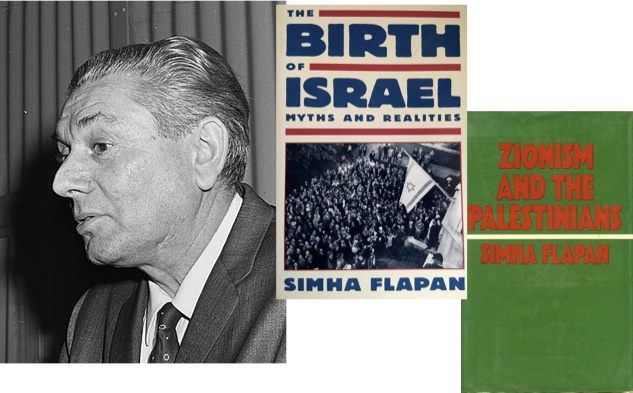
I flip over from Nur Masalha’s account to that of Simha Flapan, The Birth of Israel: Myths and Realities, beginning from page 88 (with my highlighting and formatting):
Records are available from archives and diaries, however, and while not revealing a specific plan or precise orders for expulsion, they provide overwhelming circumstantial evidence to show that a design was being implemented by the Haganah, and later by the IDF, to reduce the number of Arabs in the Jewish state to a minimum, and to make use of most of their lands, properties, and habitats to absorb the masses of Jewish immigrants.
89
It is true, of course, that many Palestinians left of their own accord. Tens of thousands of community leaders, businessmen, landowners, and members of the intellectual elite who had the means for removing their families from the scene of fighting did so. Thousands of others — government officials, professionals, and skilled workers chose to immigrate to Arab areas rather than live in a Jewish state, where they feared unemployment and discrimination. Nearly half the Arab population of Haifa moved to Nazareth, Acre, Nablus, and Jenin before their city was captured by the Haganah on April 23, 1948. The Arab quarters of Wadi Nisnas and Karmel were almost completely emptied out. . . .
But hundreds of thousands of others, intimidated and terrorized, fled in panic, and still others were driven out by the Jewish army, which, under the leadership of Ben-Gurion, planned and executed the expulsion in the wake of the UN Partition Resolution.
The balance is clear in IDF intelligence estimates. As of June 1, 1948, 370,000 Arabs had left the country, from both the Jewish parts and the Arab parts conquered by the Jews.
Therefore, 84 percent left in direct response to Israeli actions, while only 5 percent left on orders from Arab bands. The remaining 11 percent are not accounted for in this estimate and may refer to those who left voluntarily. (The total reflects only about 50 percent of the entire exodus since a similar number were to leave the country within the next six months.)
Again, it is obvious that no specific orders for expulsion could have been issued. All of the Zionist movements’ official pronouncements as well as those of the provisional government and, after January 1949, the Israeli government — and Ben-Gurion was prominent in these bodies — promised, as noted, fair treatment for the Arab minority. Moreover, in the face of the often brutal destruction and evacuation of villages, Ben-Gurion — along with other cabinet ministers — publicly criticized the brutality, looting, rape, and indiscriminate killing.
90
In private, however, Ben-Gurion was not averse to making his real views clear. Thus, on December 19, 1947, he demanded that “we adopt the system of aggressive defense; with every Arab attack we must respond with a decisive blow: the destruction of the place or the expulsion of the residents along with the seizure of the place.” He declared: “When in action we . . . must fight strongly and cruelly, letting nothing stop us.’’ Even without direct orders, the goal and spirit of real policy were understood and accepted by the army. That Ben-Gurions’ ultimate aim was to evacuate as much of the Arab population as possible from the Jewish state can hardly be doubted, if only from the variety of means he employed to achieve this purpose:
Ben-Gurion took note of the combined effects of economic, military, and psychological warfare in a diary entry from December 11, 1947:
Arabs are fleeing from Jaffa and Haifa. Bedouin are fleeing from the Sharon. Most are seeking refuge with members of their family. Villagers are returning to their villages. Leaders are also in flight, most of them are taking their families to Nablus, Nazareth. The Bedouin are moving to Arab areas. According to our “friends” [advisers], every response to our dealing a hard blow at the Arabs with many casualties is a blessing. This will increase the Arabs’ fear and external help for the Arabs will be ineffective. . . . Josh Palmon [an adviser to Ben-Gurion on Arab affairs] thinks that Haifa and Jaffa will be evacuated [by the Arabs] because of hunger. There was almost famine in Jaffa during the disturbances of 1936-1939.
91
In a letter to Sharett a few days later, Ben-Gurion focused on economic issues, observing that “the important difference with [the riots of] 1937 is the increased vulnerability of the Arab urban economy. Haifa and Jaffa are at our mercy. We can ‘starve them out.’ Motorized transport, which has also become an important factor in their life, is to a large extent at our mercy.”
The destruction of the Palestinian urban bases, along with the conquest and evacuation (willing or unwilling) of nearby villages, undermined the whole structure of Palestinian life in many parts of the country, especially in the towns. Ben-Gurion’s advisers urged closing stores, barring raw materials from factories, and various other measures.
Clearly, significant numbers of Arabs without food, work, or the most elementary security would choose to leave, especially given that almost all of their official leadership had left even before the fighting began.
92
On January 5, 1948, Ben-Gurion was able to review in his diary some of the effects of economic warfare on the Arabs of Haifa: “[Their] commerce has for the most part been destroyed, many stores are closed . . . prices are rising among the Arabs.” He noted that up to twenty thousand Arabs had left, including many of the wealthier people, whose businesses were no doubt among those destroyed.
Ben-Gurion’s belief in the efficacy of the policy of destroying the Arab economy led him to monitor its results constantly. Thus, on January 11, 1948, he noted in his diary a telephone conversation between Hussein al-Khalidi, secretary of the Arab Higher Committee and former mayor of Jerusalem, and the banker Farid Bey, in Haifa. Farid Bey told Khalidi of the desperate situation in Jerusalem and Haifa. “You have no idea how hard it is outside,” Khalidi replied, referring to the Arab leadership abroad. Farid Bey responded, “And here [Arabs] are dying day by day.” “It is even worse in Jaffa,” said Khalidi. “Everyone is leaving.”
That same day, Sasson reported to King Abdallah that the Palestinians in Haifa, Jaffa, and Jerusalem were facing “hunger, poverty, unemployment, fear, terror.” Two days later, on January 13, Khalidi informed the mufti of the crisis: “The position here is very difficult,” he reported from Jerusalem. “There are no people, no discipline, no arms, and no ammunition. Over and above this, there is no tinned food and no foodstuffs. The black market is flourishing. The economy is destroyed. . . . This is the real situation, there is no flour, no food. . . . Jerusalem is emptying out.”
The urban disintegration of the Palestinian Arabs was a fait accompli. Ben-Gurion’s tactics had succeeded. As he explained it:
The strategic objective [of the Jewish forces] was to destroy the urban communities, which were the most organized and politically conscious sections of the Palestinian people. This was not done by house-to-house fighting inside the cities and towns, but by the conquest and destruction of the rural areas surrounding most of the towns. This technique led to the collapse and surrender of Haifa, Jaffa, Tiberias, Safed, Acre, Beit-Shan, Lydda, Ramleh, Majdal, and Beersheba. Deprived of transportation, food, and raw materials, the urban communities underwent a process of disintegration, chaos, and hunger, which forced them to surrender.
93
The military campaign against the Arabs, including the “conquest and destruction of the rural areas,” was set forth in the Haganah’s Plan Dalet [which I will outline in my next post]. Plan D, formulated and put into operation in March 1948, went into effect “officially” only on May 14, when the state was declared. The tenets of the plan were clear and unequivocal: The Haganah must carry out “activities against enemy settlements which are situated within or near to our Haganah installations, with the aim of preventing their use by active [Arab] armed forces.” These activities included the destruction of villages, the destruction of the armed enemy, and, in case of opposition during searches, the expulsion of the population to points outside the borders of the state.
Also targeted were transport and communication routes that might be used by the Arab forces. According to an interview with Yadin some twenty-five years later, “The plan intended to secure the territory of the state as far as the Palestinian Arabs were concerned, communication routes, and the strongholds required.” Yadin and his assistants outlined nine courses of operation that included “blocking the access roads of the enemy from their bases to targets inside the Jewish state,” and the “domination of the main arteries of transportation that are vital to the Jews, and destruction of the Arab villages near them, so that they shall not serve as bases for attacks on the traffic.”
The plan also referred to the “temporary” conquest of Arab bases outside Israeli borders. It included detailed guidelines for taking over Arab neighborhoods in mixed towns, particularly those overlooking transport routes, and the expulsion of their populations to the nearest urban center.
The psychological aspect of warfare was not neglected either. The day after the plan went into effect, the Lebanese paper Al-Hayat quoted a leaflet that was dropped from the air and signed by the Haganah command in Galilee:
We have no wish to fight ordinary people who want to live in peace, but only the army and forces which are preparing to invade Palestine. Therefore . . . all people who do not want this war must leave together with their women and children in order to be safe. This is going to be a cruel war, with no mercy or compassion. There is no reason why you should endanger yourselves.
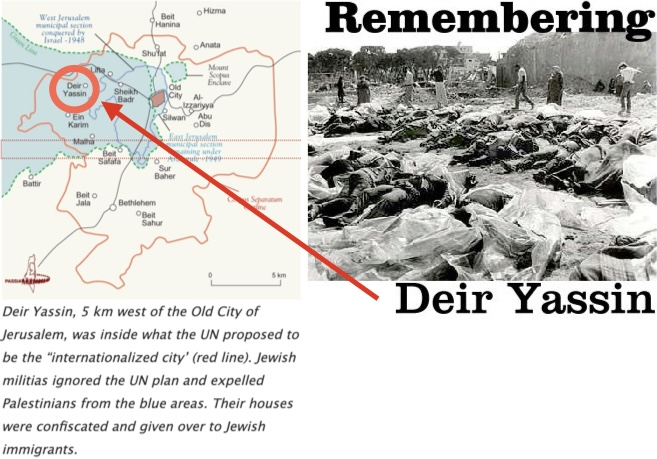
94
Exactly how cruel and merciless was already clear from the example of the Dir Yassin massacre. The village of Dir Yassin was located in a largely Jewish area in the vicinity of Jerusalem and, as already noted, had signed a nonaggression pact with its Jewish neighbors as early as 1942. As a result, its inhabitants had not asked the Arab Higher Committee for protection when the fighting broke out. Yet for the entire day of April 9, 1948, Irgun and LEHI soldiers carried out the slaughter in a cold and premeditated fashion. In a 1979 article dealing with the later forced evacuation of Lydda and Ramleh, New York Times reporter David Shipler cites Red Cross and British documents to the effect that the attackers “lined men, women and children up against walls and shot them,” so that Dir Yassin “remains a name of infamy in the world.” When they had finished, they looted the village and fled.
The ruthlessness of the attack on Dir Yassin shocked Jewish and world public opinion alike, drove fear and panic into the Arab population, and led to the flight of unarmed civilians from their homes all over the country.
I have jumped ahead a little. I need to backtrack to clarify a little more in the next post what the Zionist Plan D (Dalet) was all about.
Flapan, Simha. The Birth of Israel: Myths and Realities. New York: Pantheon Books, 1987.
Flapan, Simha. Zionism and the Palestinians. London: Harper & Row, 1979.
Masalha, Nur. Expulsion of the Palestinians: The Concept of “Transfer” in Zionist Political Thought, 1882-1948. Washington, D.C: Institute for Palestine Studies, 1992.
Morris, Benny. The Birth of the Palestinian Refugee Problem, 1947-1949. Cambridge: Cambridge University Press, 1987. https://archive.org/details/birthofpalestini00morr/mode/2up
McDonald, James G. My Mission In Israel 1948-1951. Simon And Schuster, 1951. http://archive.org/details/mymissioninisrae002443mbp

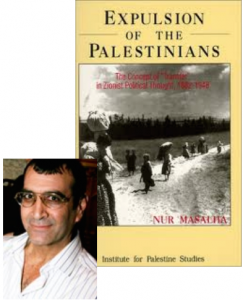 Posts covering Nur Masalha’s book, Expulsion of the Palestinians: The Concept of “Transfer” in Zionist Political Thought, 1882-1948: . . .
Posts covering Nur Masalha’s book, Expulsion of the Palestinians: The Concept of “Transfer” in Zionist Political Thought, 1882-1948: . . .
. . .

In case certain details were not reported on your local news media…..
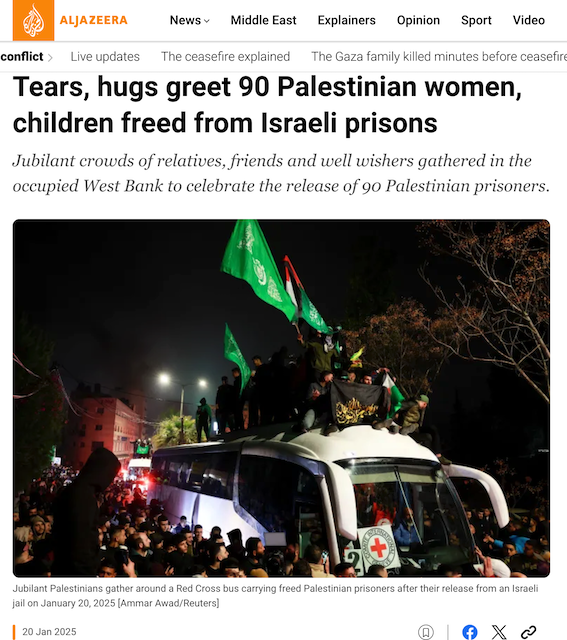
You can read their names and other biographhical details here.
Per the custom on hearing good news handing out sweets, Brisbane, Sunday 19th January ….
One of the Palestinian speakers at Sunday’s rally, Remah Naji, will be the first Palestinian elected to Federal Parliament if she wins the seat of Moreton. The right wing Advance Australia party has set aside ten million dollars in an effort to remove the only voices standing up for Palestine from the Australian Parliament.

 Compare . . .
Compare . . .A fundamentalist Christian view:
Since becoming a nation in 1948, the Israelis have developed a productive, fertile and wealthy nation in a desert wasteland. They have been outstanding custodians of their homeland. . . .
. . . . many Palestinian Muslims believe they also have a religious claim to the land of Palestine. That is why they have fought and will continue to fight so ferociously for it.
When Jews began to immigrate to Palestine in large numbers in 1882, fewer than 250,000 Arabs lived there, and the majority of them had arrived in recent decades. Palestine was never an exclusively Arab country, although Arabic gradually became the language of most of the population after the Muslim invasions of the seventh century. No independent Arab or Palestinian state ever existed in Palestine. When the distinguished Arab-American historian, Princeton University Prof. Philip Hitti, testified against partition before the Anglo-American Committee in 1946, he said: “There is no such thing as ‘Palestine’ in history, absolutely not.” In fact, Palestine is never explicitly mentioned in the Koran . . . .”
Prior to partition, Palestinian Arabs did not view themselves as having a separate identity. When the First Congress of Muslim-Christian Associations met in Jerusalem in February 1919 to choose Palestinian representatives for the Paris Peace Conference, the following resolution was adopted:
We consider Palestine as part of Arab Syria, as it has never been separated from it at any time. We are connected with it by national, religious, linguistic, natural, economic and geographical bonds.
In 1937, a local Arab leader, Auni Bey Abdul-Hadi, told the Peel Commission, which ultimately suggested the partition of Palestine: “There is no such country [as Palestine]! ‘Palestine’ is a term the Zionists invented! There is no Palestine in the Bible. Our country was for centuries part of Syria.”
The Jewish Policy Center:
“A land without a people for a people without a land” is a phrase that gets under the skin of most Palestinians, who think that the authors of the phrase looked at Ottoman Palestine, did not see them, and instead saw an empty land. Yet perhaps this phrase would have made sense if we zoomed in on the meaning of the word “people.”
Whoever coined the phrase that became a Zionist slogan did not use the word people to describe a bunch of humans dwelling on a certain land. People, in this phrase, is used to mean a nation, a state or a nation-state.
Before 1948, the Arabs who lived in Palestine had never organized themselves in a state, but had, for centuries, lived as subjects of empires that ruled them from faraway capitals, such as Damascus, Cairo, Baghdad, and Istanbul. In the history of the Arabs, Jerusalem never served as the seat of any dynasty and never practiced sovereignty. At best, the city served as a provincial capital. In this sense, when the Zionists looked at Ottoman Palestine, they did not see a nation-state. They saw Arab provinces of successive empires, Arab or Turkish. This is why the land looked one without a people, that is without a nation state.
Historically, the word “Palestinian” did not refer to Arabs living in the region, but to the region itself. Some 100 years ago, the land was administered by the British, and its inhabitants were Jewish, Christian and Muslim – all of whom were identified as “Palestinian.” However, for most, their primary identity was not their nationality, but their religion.
Indeed, many Arabs bristled at being called “Palestinian,” voicing strong opposition to the label. Instead, they saw themselves first and foremost as Arabs or Muslims. Only in the mid-1960s was the word co-opted to mean Arabs.
Hence, before 1948, it would not have made sense to talk about Palestinians as opposed to Jews. The population was divided into two primary groups: Jewish and Arab.
This makes sense because a sovereign Palestinian state never existed. Therefore, there were no “Palestinian lands.” Rather, the land was part of the Mandate for Palestine, a geographical area controlled by the British after the collapse of the Ottoman Empire at the end of the First World War.
From The Rohr Jewish Learning Institute:
The Palestinian peasant was indeed being dispossessed, but by his fellow-Arabs: the local sheikh and village elders, the Government tax-collector, the merchants and money-lenders; and, when he was a tenant-farmer (as was usually the case), by the absentee-owner. By the time the season’s crop had been distributed among all these, little if anything remained for him and his family, and new debts generally had to be incurred to pay off the old. Then the Bedouin came along and took their “cut”, or drove the hapless fellah off the land altogether.
This was the “normal” course of events in 19th-century Palestine. It was disrupted by the advent of the Jewish pioneering enterprise, which sounded the death-knell of this medieval feudal system. In this way the Jews played an objective revolutionary role. Small wonder that it aroused the ire and active opposition of the Arab sheikhs, absentee landowners, money-lenders and Bedouin bandits.
Comment:
. . . . Note that the local Arabs never claimed that they had a sovereign country.
[This history] refers to the groups that as a rule live outside the realm of politics and power. . . . The narrative is clear; it begins with a society in Palestine as remote as possible from politics in the late Ottoman period . . . .
They are not one mass of people. They are grouped according to choice in small social units, usually households. But, with time, they prefer to define themselves via ethnicity, gender, occupation, class or culture. They change at will, but at times are forced to, not always to their advantage. Their world is a mix of material necessity and spiritual solace. Many of them are closely connected to the land where they live or chose to settle on. They cling to the land or to their property not from a national imperative to protect the mother/fatherland, the entity, but for much more mundane and at the same time humane reasons.
These local actors are leaders as well as ordinary members of the community. They are Palestine’s women and children, peasants and workers, town dwellers and farmers. They are defined according to their religious or ethnic origins as Armenians, Druzes, Circassians, or Mizrahi and Ashkenazi Jews, as well as to their views on religion, whether secular, orthodox or fundamentalist. In writing about them, definitions call for a balance between their own claims and the author’s understanding of what groups them together. Feeding a family, staying on the family land or attempting to make a new life on foreign soil can be portrayed as patriotism or nationalism: for most people it is an existentialist and survivalist act. (bolding added)
So begins (pages 8-9) the history of the land by a Jewish historian:
(I am reminded of the way our nineteenth century ancestors (who had migrated thousands of miles from their homeland) erroneously portrayed the Australian aborigines as “nomadic”, with the implication that they had no notion of attachment to any land. It is a colonialist mind-set that has always “justified” ethnic cleansing and genocide. (I use the word “genocide” according to its meaning as defined by the originator of the word, Raphael Lemkin.)

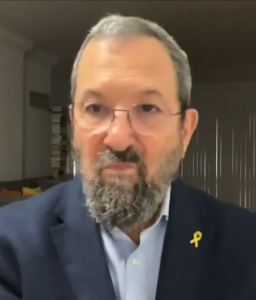
Former Prime Minister of Israel, Ehud Barak, speaking on Australia’s national current affairs program, 7.30, about the reason for the government of Israel refusing to declare a truce to free the hostages and for continuing the war (“if someone would have said we would still be stuck in Gaza after a year no-one would have believed it” @ 28:40) and even expanding it into the West Bank and Lebanon. The specific question Barak was responding to was whether “right wing elements within [Netanyahu’s] cabinet” ride their “successes” in the current war to continue to expand Israeli settlements in the West Bank….
Oh sure. For sure they will do it. They do it even without this. They want a settlement… And if we wait for too long they might raise some idea that we had some promise from some corner of the Bible to get some part of Lebanon. They are Messianic Jewish supremacists, racists, of the worst kind. I compare them to the Proud Boys of America, those who were behind the 6 January event. So, think of the American President, who would nominate one of these leaders from the program to be secretary of treasury with certain formal roles and the other one to be in charge of national security, of homeland security. That’s crazy but that’s exactly what Netanyahu did because he needs tight control for the survival of the government. If there is even a ceasefire, in order to exchange the hostages and a ceasefire for four months, immediately it will become a day of reckoning because people will demand to establish a national investigation, a committee led by a Supreme Court judge, to find who is responsible for the worst day in our history. (@ 26 mins 55 secs)
(Of course, Barak is introduced as “having come very close to securing peace with the Palestinians” when he was Prime Minister. We are rarely reminded that the “best deal” the Palestinians were ever offered was a “state” divided into four island-regions, each surrounded by Israeli settlements or territory. The above quotation is not meant to imply agreement with every other view Barak expressed in the 7.30 interview. — No thought, of course, that there might be “a day of reckoning” to investigate responsibility for expulsions and killings of Palestinians since 1948.)

* The anthropologist’s work I have just completed is fully in line with similar kinds of analyses of the causes of radicalization and extremist, even suicidal, acts of mayhem — Scott Atran, Jason Burke, Robert Pape, William McCants, Jessica Stern and J.M. Berger, Bruce Hoffman, Anne Speckhard, Raffaello Pantucci, Riaz Hassan, Loretta Napoleoni, Michael Weiss and Hassan Hassan (sic), Clark McCauley and Sophia Moskalenko, Peter Neumann, Ghassan Hage, Thomas Hegghammer, Richard Jackson, Ed Husain, Mohammed M. Hafez, Lorne L. Dawson, Quintan Wiktorowicz, Nate Rosenblatt — along with specialist studies of Hamas itself. The point being that the arguments are supported by mountains of research studies.
— I have posted on the research of the above (and others) on this blog. Search under the tags “radicalization” and “terrorism”.
Among the initiators of the The Palestine History and Heritage Project (PaHH) (that I spoke about recently in Imagine Palestine) was Dr Ilan Pappé. Pappé has written a sobering article in which he sees some hope for both Jews and Arabs beyond the current horrors. I’ve read in past years opinions by various hopefuls that “this time” we will see the beginning of the demise of an aggressive power only to have such thoughts wisp away into nothingness. But one thing is certainly clear as day — and this comes just after I have finished reading the latest work by a prominent anthropologist* in which he addresses the nature of “band of brothers” type bonding and willingness to sacrifice one’s life in resistance to an overwhelming force — and in that light it is clearer than ever that even if Israel manages to kill every current Hamas fighter it will inherit only more waves of like minded resistance fighters to battle.
Pappé draws comparisons with the last days of South Africa’s apartheid regime. Some of us will recall how SA’s use of horrific violence to maintain its system only convinced us that it would never change.
. . . Hamas’s assault of October 7 can be likened to an earthquake that strikes an old building. The cracks were already beginning to show, but they are now visible in its very foundations. More than 120 years since its inception, could the Zionist project in Palestine – the idea of imposing a Jewish state on an Arab, Muslim and Middle Eastern country – be facing the prospect of collapse? . . .
. . . Here, I will argue that [the early indicators] are clearer than ever in the case of Israel. We are witnessing a historical process – or, more accurately, the beginnings of one – that is likely to culminate in the downfall of Zionism. And, if my diagnosis is correct, then we are also entering a particularly dangerous conjuncture. For once Israel realizes the magnitude of the crisis, it will unleash ferocious and uninhibited force to try to contain it, as did the South African apartheid regime during its final days.
A first indicator is the fracturing of Israeli Jewish society. At present it is composed of two rival camps which are unable to find common ground. . . .
One camp can be termed the ‘State of Israel’. It comprises more secular, liberal and mostly but not exclusively middle-class European Jews and their descendants, who were instrumental in establishing the state in 1948 . . . .
The other camp is the ‘State of Judea’, which developed among the settlers of the occupied West Bank. It enjoys increasing levels of support within the country and constitutes the electoral base that secured Netanyahu’s victory . . . .
. . . . More than half a million Israelis, representing the State of Israel, have left the country since October, an indication that the country is being engulfed by the State of Judea. This is a political project that the Arab world, and perhaps even the world at large, will not tolerate in the long term.
The second indicator is Israel’s economic crisis. . . . The conflict between the State of Israel and the State of Judea, along with the events of October 7, is meanwhile causing some of the economic and financial elite to move their capital outside the state. Those who are considering relocating their investments make up a significant part of the 20% of Israelis who pay 80% of the taxes.
The third indicator is Israel’s growing international isolation, as it gradually becomes a pariah state. This process began before October 7 but has intensified since the onset of the genocide. It is reflected by the unprecedented positions adopted by the International Court of Justice and International Criminal Court. . . .
The fourth … indicator is the sea-change among young Jews around the world. Following the events of the last nine months, many now seem willing to jettison their connection to Israel and Zionism and actively participate in the Palestinian solidarity movement. . . .
The fifth indicator is the weakness of the Israeli army. There is no doubt that the IDF remains a powerful force with cutting-edge weaponry at its disposal. Yet its limitations were exposed on October 7. . . .
The final indicator is the renewal of energy among the younger generation of Palestinians. It is far more united, organically connected and clear about its prospects than the Palestinian political elite. Given the population of Gaza and the West Bank is among the youngest in the world, this new cohort will have an immense influence over the course of the liberation struggle. The discussions taking place among young Palestinian groups show that they are preoccupied with establishing a genuinely democratic organization – either a renewed PLO, or a new one altogether – that will pursue a vision of emancipation which is antithetical to the Palestinian Authority’s campaign for recognition as a state. They seem to favour a one-state solution to a discredited two-state model. . . .
Pappé, Ilan. “The Collapse of Zionism.” NLR/Sidecar, June 21, 2024. https://newleftreview.org/sidecar/posts/the-collapse-of-zionism?pc=1610.
To refer back to my latest reading, Inheritance by Harvey Whitehouse: The best we might dare hope for is the emergence of a boundary-crossing leadership, of which Nelson Mandela was a clear example. Two key works cited:
We have seen young Jewish Israelis and Arab Palestinians working together for justice and assistance for many years now (though their efforts have not made headlines) — so the possibility of that kind of leadership after the slaughter has ended is not out of the question. Though an acceleration of violence in the meantime seems inevitable.

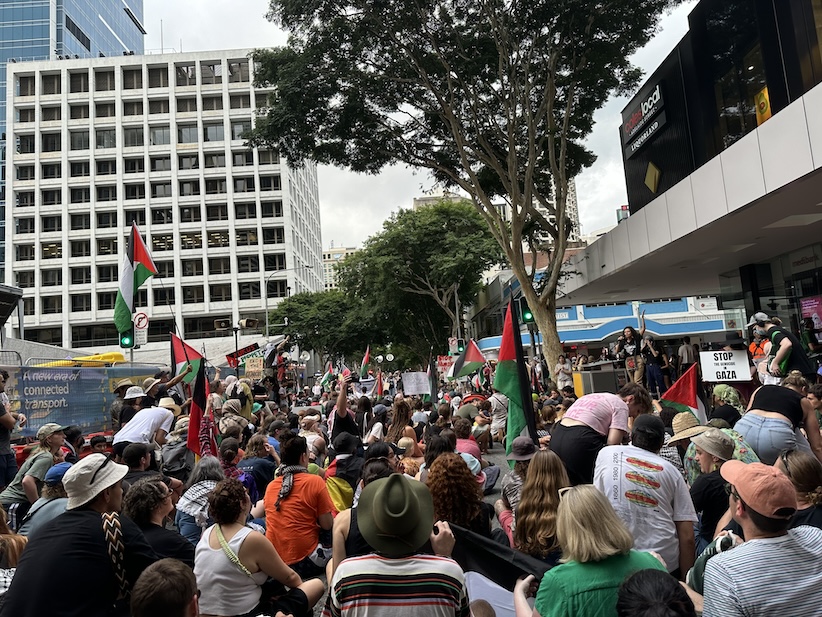 Several hundred, young and old, held a public rally and march today calling for federal, state and local governments to cut direct support for Israel and businesses doing business with Israel at this time. Not many by a long shot, and of course it was ignored even by the local TV news media. Among the speakers was one from a very small number of anti-Zionist Jews. He spoke of some of his extended family refusing to have anything to do with him because of his stance. I took it as a disheartening reality check that the newly formed Jewish Council of Australia is a not a large body.
Several hundred, young and old, held a public rally and march today calling for federal, state and local governments to cut direct support for Israel and businesses doing business with Israel at this time. Not many by a long shot, and of course it was ignored even by the local TV news media. Among the speakers was one from a very small number of anti-Zionist Jews. He spoke of some of his extended family refusing to have anything to do with him because of his stance. I took it as a disheartening reality check that the newly formed Jewish Council of Australia is a not a large body.
It was interesting to hear that it is worth trying to pressure even local government to take a stand. The Brisbane City Council had our Story Bridge lit up in the colours of the Israeli flag after the October 7 events (though all the emphasis in the news at the time, and the news that shocked the world, was not on the crimes that Hamas did commit but on the crimes that they did not commit). Since then, requests to light up colours in support of Gaza at this time have been flatly rejected.
There’s a long way to go yet. Something happens to you when you are involved in a rally and march like that. I have learned enough about the nature of rituals from studies of religion to recognize how this ritual works in a similar way: the bonding one feels with others, with seriousness of purpose but with good humour and camaraderie, the vicarious identification with distant people and events and the bringing of those distant people and events close to us. The drums, the applauding, the chanting, the laughter — bonding all to something bigger. Some rituals are acted out behind closed doors. Others are public and meant to be noticed. Hopefully in shorter time rather than too much longer more of those bystanders who appear to look at us as if we were strange exhibits in a circus parade (or simply as “bad protesters”) will learn more about why we are doing what we are doing and also take action in different ways. It’s happened before. But I don’t want to look back and say I did nothing. I met our local member/representative a few days ago. I will let him know what government action I believe he should be pushing for. I’d like to do a little more in cooperation with local activists to help raise public awareness — to add one more voice to those pushing back against the local impact of mainstream media and the pablum spin of politicians.

There was a time when I felt reasonably confident that the views of the Zionist extremist Meir Kahane would never become dominant in Israel. Surely, they would always be confined to the margins.
Then Netanyahu formed government with the religious extremists. How on earth did it turn out this way?
I failed to understand that Kahane was as much against the idea of Diaspora Jews as he was against anything else, and how propaganda and activism towards this end would play out.
David Sheen explains it well. His presentation in 2019 effectively predicted the events unfolding in Gaza and the West Bank today, including scenes captured in videos that I had naively believed the West had buried in 1945.
Sheen begins with the views that have been preached by government appointed rabbis to Israel’s military. Those views even openly align with the racist and genocidal proclamations of Hitler — with the only difference being that Hitler was mistaken in identifying the master race with the Aryans.
The video explains “the four types” of Jews as they are aligned with the Jewish sacred books, the Torah and Talmud.
| Liberal (Reformist) |
|
| Torah = Holy |
Torah ≠ Just Torah laws need reform to align it with modern values. |
| Nationalist (Opportunist) |
|
| Torah ≠ Holy |
Torah = Just God gave Jews the land of Palestine, therefore they have an obligation to take it. |
| Religious (Supremacists) |
|
| Torah = Holy |
Torah = Just Traditionally held that God would give Jews the land and make the gentiles willing slaves of the Jews; not for Jews to act but to wait for God to do it. |
| Socialist (Humanist) |
|
| Torah ≠ Holy |
Torah ≠ Just |
The video explains how the middle two, the nationalist and the religious (supremacist) have joined forces under Netanyahu.

. . . .
The Israelis responsible even had the intelligence that the Hamas attack was imminent (they even had the Hamas plans and saw them running to the fence barrier on the morning of the 7th) but dismissed it all thinking it incredible.
The failure of the Israeli defence forces was astonishing. Hamas expected to suffer 80% casualties and that only 20% of them would return alive. In fact the figures were reversed. And it was the Israeli military posts they attacked that suffered the incredible losses. Hamas had no plans for the unexpected situation they found themselves in.
Hamas crimes, yes, but no evidence of rape, no beheaded or oven-burned babies.
The mutilated bodies, those stabbed and burned and run over, appear to have been Palestinian, not Israeli.
Israeli tanks and Apache helicopters fired into houses and cars killing Israelis as well as Hamas.
Like the propaganda following Germany’s 1914 invasion of Belgium – stories of bayoneting women and children . . . .
Like the 1939 lie by Hitler that Poland had attacked Germany . . . .
Like the Gulf of Tonkin lie to justify the Vietnam war . . . .
Like the lie of Iraqis in Kuwait throwing babies from incubators prior to the 2003 Gulf war . . . .
Like the lie of weapons of mass destruction to justify the 1993 Iraq war . . . .
. . . . The October 7 dehumanizing lies serve to justify the slaughter under way in Gaza (and of course to deflect from the utter failure of the Israeli defence force on that morning.)
A brief extract:

A historian is supposed to stimulate thought. A historian who insists on being neutral, a person of footnotes, and does not provoke, is doing a disservice to the profession.
When I think about Germany and about German historians who constantly hid behind the ‘neutrality’ and ‘objectivity’ of history, I know where that leads.
Those who are colorless, who are neither here nor there, in the end collaborate with what exists.
— Moshe Zimmermann, emeritus professor at the Hebrew University of Jerusalem
A classic example of the “purely objective” historian is another Israeli, Benny Morris, whose works on the events connected with the founding of Israel are widely known.
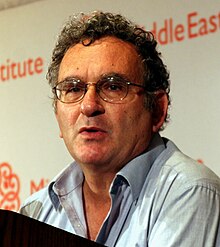
In 2004 Counterpunch published an interview with Benny Morris that opened with this paragraph:
Note: Benny Morris is the dean of Israeli ‘new historians’, who have done so much to create a critical vision of Zionism–its expulsion and continuing oppression of the Palestinians, its pressing need for moral and political atonement. His 1987 book, The Birth of the Palestinian Refugee Problem, chronicled the Zionist murders, terrorism, and ethnic cleansing that drove 600,000-750,000 Palestinians from their homes in 1948, thus refuting the myth that they fled under the orders of Arab leaders. A second edition of this book is due out this month [= the green cover on the right], chronicling even more massacres, and a previously unsuspected number of rapes and murders of Palestinian women. Thus Morris continues to provide crucial documentation for Palestinians fighting the heritage of Al-Nakba, “The Catastrophe.”
But it was all objectively told and the historian author in fact personally lamented that the expulsion of the Palestinians at that time was left as unfinished business:
But in an astonishing recent Ha’aretz interview, after summarizing his new research, Morris proceeds to argue for the necessity of ethnic cleansing in 1948. He faults David Ben-Gurion for failing to expel all Arab Israelis, and hints that it may be necessary to finish the job in the future. Though he calls himself a left-wing Zionist, he invokes and praises the fascist Vladimir Jabotinsky in calling for an “iron wall” solution to the current crisis. Referring to Sharon’s Security Wall, he says, “Something like a cage has to be built for them. I know that sounds terrible. It is really cruel. But there is no choice. There is a wild animal there that has to be locked up in one way or another.” He calls the conflict between Israelis and Arabs a struggle between civilization and barbarism, and suggests an analogy frequently drawn by Palestinians, though from the other side of the Winchester: “Even the great American democracy could not have been created without the annihilation of the Indians.”
Continue reading “The “Objective” and “Neutral” Historian Versus the Provocateur”